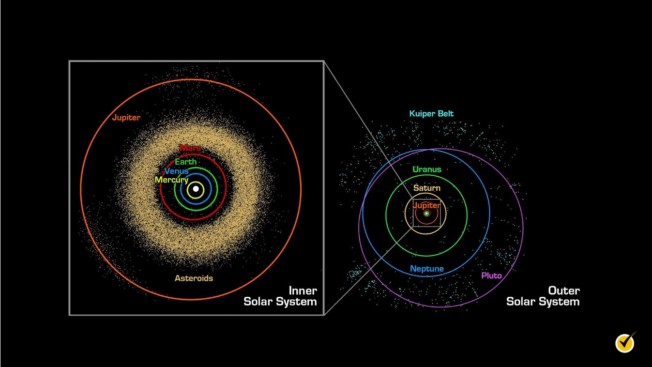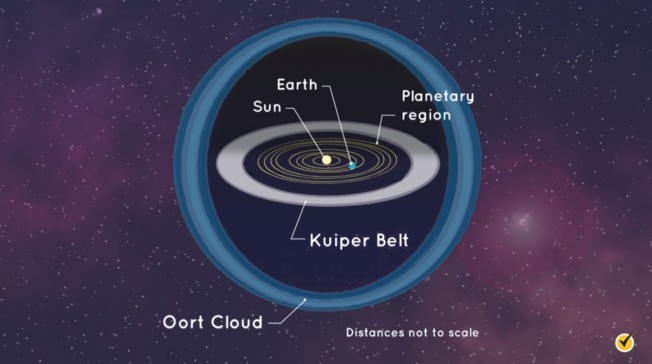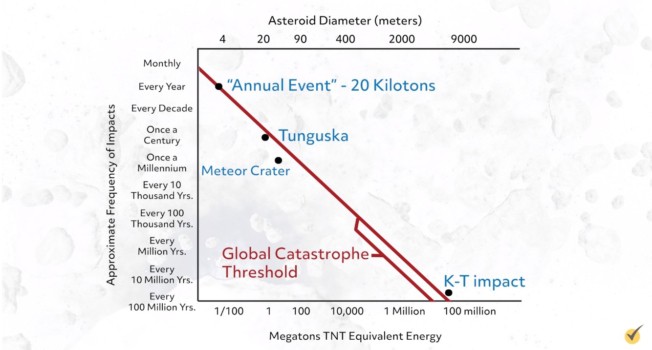Comets, Asteroids, and Meteoroids

The solar system is home to all sorts of celestial bodies, such as planets, moons, and the Sun. It also contains various kinds of planetary debris, which includes comets, asteroids, and meteoroids. They originate far, far away and orbit our Sun over long periods of time, and, on occasion, even crash into the Earth!
Comet Formation and Types
Comets are a combination of rock and ice. They form far from the Sun where the lack of solar energy means temperatures are cold and ices can more easily form. The nucleus is the central part of the comet and it is the only part that is likely to survive in proximity to the Sun.
When a comet does approach the Sun, the warmer environment causes the ices on the comet to evaporate, forming a cloud of particles and steam called the comet’s coma. As this material streams away from the comet, it forms two tails.
The plasma tail—sometimes called the ion tail—is composed of electrically charged particles trapped in the solar wind. The plasma tail often appears blue. It always points directly away from the Sun. It does not indicate the direction of the comet’s motion. A second yellow or whitish tail is composed of dust. The dust tail is both pushed by solar radiation and left behind along the comet’s orbit, so the dust tail does show where the comet came from. This dust will remain in space. Earth’s meteor showers are the effect of the Earth passing through the leftover dust tails of comets.
There are two families of comets in the solar system.

Short period comets have orbital periods that bring them back into the inner solar system on predictable schedules of every 200 years or less, such as Halley’s comet which has a period of about 76 years. These short period comets come from the flat Kuiper Belt of debris that lies just beyond the orbit of Neptune. Notice they do not come from the asteroid belt just beyond Mars. This is because the asteroid belt is too close to the Sun for ice and only objects containing ice become comets. Short period comets spend most of their time in the Kuiper Belt. They have highly elliptical orbits that bring them close to the Sun for only a little while. For instance, Halley’s comet spends only a few months in the inner solar system and then the majority of its 76-year orbit far away from the Sun.
You may recall learning Kepler’s Second Law of Planetary Motion, which states that planetary orbits sweep out equal areas in equal times. A more clear way of stating Kepler’s Second Law is that a single object will move faster when it is closer to the Sun and slower when it is farther away. Every time the comet does come close to the Sun, it loses material. Eventually a given comet will evaporate all of its icy material and fall apart, though many come so close to the Sun that they are vaporized.

Long period comets orbit the Sun with periods greater than 200 years. Many have periods of tens or hundreds of thousands of years, so there is no way to predict their visit before the comet is seen. Long period comets originate in the Oort Cloud. The Oort Cloud is a spherical reservoir of comets at the edge of the solar system. This region of our solar system has never been photographed because it is so dark and distant, but our long period comets come in from every direction and must exist somewhere when they are not passing through the region near the Sun. Note that this is different from interstellar objects, which are moving so quickly that they are not in orbit around the Sun but truly just passing through.
Asteroids, by contrast, are rocky bodies containing very little frozen material. They form inside the frost line, in the same region as the terrestrial planets. Most asteroids are in the main belt between Mars and Jupiter, though there are many asteroids outside of this belt. The asteroid belt exists because Jupiter’s gravity was too disruptive to allow this material to form a planet. Instead, the gravitational disturbance from Jupiter caused many objects to leave the asteroid belt, some of which have crashed into the Earth.
Impact Threats
The fact that asteroids and parts of asteroids do sometimes impact the Earth has shaped Earth’s geographical and biological history.

The frequency of impact depends on the size of the impactor. Asteroids less than a meter in size are classified as meteoroids and enter the Earth’s atmosphere on average about once per hour. These will vaporize and break apart in the atmosphere causing a streak of light known as a meteor, though you may know it by the more common name of a “shooting star.” Asteroids enter the Earth’s atmosphere so fast that friction with air causes an intense heat. Those that are at least ten meters in size are visible when they enter the atmosphere even in the daytime sky. These are called fireballs or bolides and happen less frequently, about once a year on average. Every thousand years or so, the Earth is hit by an object a hundred meters across.
If an impactor were a kilometer in size, such an object would cause tsunamis, earthquakes, and widespread devastation. An object ten kilometers across would cause a massive amount of material to go up into the atmosphere. This material would block sunlight, killing plants and making food scarce for the animals that rely on plants. The end result of such an impact is a mass extinction. Mass extinctions from asteroids happen on average every hundred million years. The extinction of the dinosaurs 65 million years ago is only the most recent example in a series of mass extinctions stretching back four billion years to the origins of life on Earth. The likelihood of something a hundred kilometers in diameter striking the Earth is very low. Some believe that an impact like that has only happened once in Earth’s history in an event that caused the formation of the Moon, and is not expected to happen again.
However, there is good reason to be concerned about smaller asteroid impacts of about 50 meters across. Such events happen on average once a century. If the impact were to occur in a rural area or the middle of the ocean, it may not be very disruptive. However, if such an impactor were to strike a highly populated area, many people could die from a relatively small object. In 1908, an asteroid about 80 meters in diameter exploded over Northern Siberia. No one died from this asteroid explosion, but in a different location, hundreds of thousands of people might have died. Because such events can happen every one hundred to five hundred years, humans need to be able to predict and prevent these events. To that end, there are scientists who attempt to map the orbits of any asteroid that may pass Earth. There are also plans in place to divert any such object that poses a threat to Earth.
Scientists are also learning to spot debris in the fossil record of Earth. For example, there is clear evidence of asteroid debris in the division between the Earth layers where there are and are not dinosaur bones.
Scientists are finding that there are many places on the Earth where asteroid impacts have shaped the Earth, sometimes in very literal ways. Impact craters can be identified from the composition of elements present in the ground. Asteroids are of interest in space exploration and mineral mining as well. Without a doubt, asteroids have shaped humanity’s past and will shape its future.
Meteorites
Any celestial object is called a meteorite once it is on the ground. Meteorites present an easy and convenient way to sample asteroids without leaving our home planet. They are broadly grouped into three categories.
Iron meteorites are made of iron and nickel.
Stony meteorites are made of silicate molecules, sometimes with a high carbon-containing molecular component. This is the same general composition as Earth rock.
Stony-iron meteorites are a roughly equal mixture of these two compositions.
Most meteorites are stony, but most of the ones that you will find in museum collections are iron. The reason for this disparity is that a stony meteorite looks like an Earth rock, whereas an iron meteorite is much more noticeable. Metal detectors also work on iron meteorites and not stony meteorites. Most stony meteorites are discovered in Antarctica because there are fewer surface rocks there. A rock sitting on top of a field of permafrost in Antarctica had no way to get there except falling from the sky. Stony-iron meteorites are rare.
The debris in our solar system is of interest to scientists not only because of the threat impactors pose to the Earth, but because this debris has been in the solar system untouched for billions of years. These rocks have the same composition as the rocks that formed the planets, so they can give us information about how the solar system and the planets formed. Most are about 4.5 billion years old and have not melted or changed or even touched another object since before the Earth formed.
That’s all for now, thanks for watching and happy staring at the sky in abject terror waiting to be crushed by an meterorastrite.
